
Securing a Vision
VERSATILE INTERNATIONAL'S WAJDI MARROUN , DISCUSSES THE SOURCING AND INSTALLATION OF NATURAL STONES IN THE REGION IN LINE WITH A DEVELOPER'S VISION






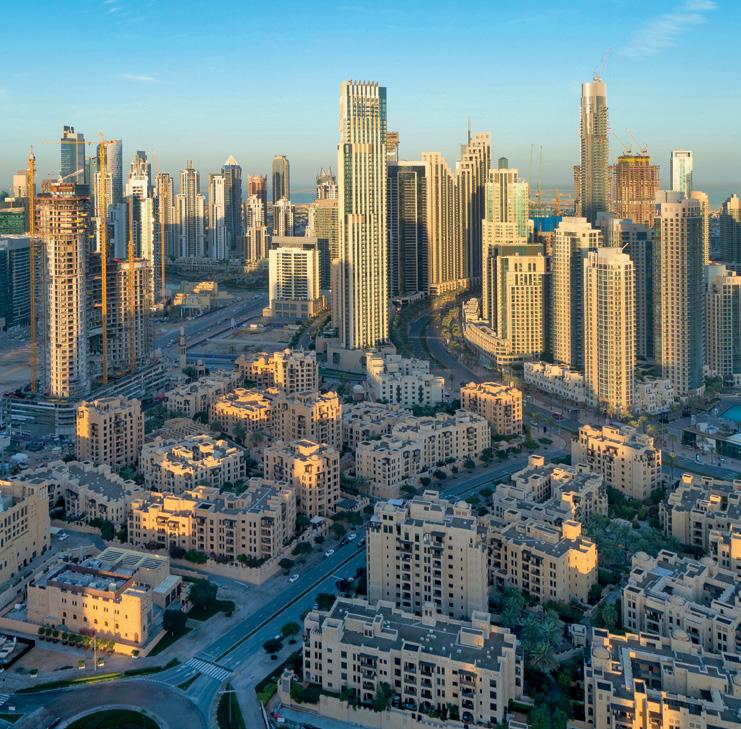
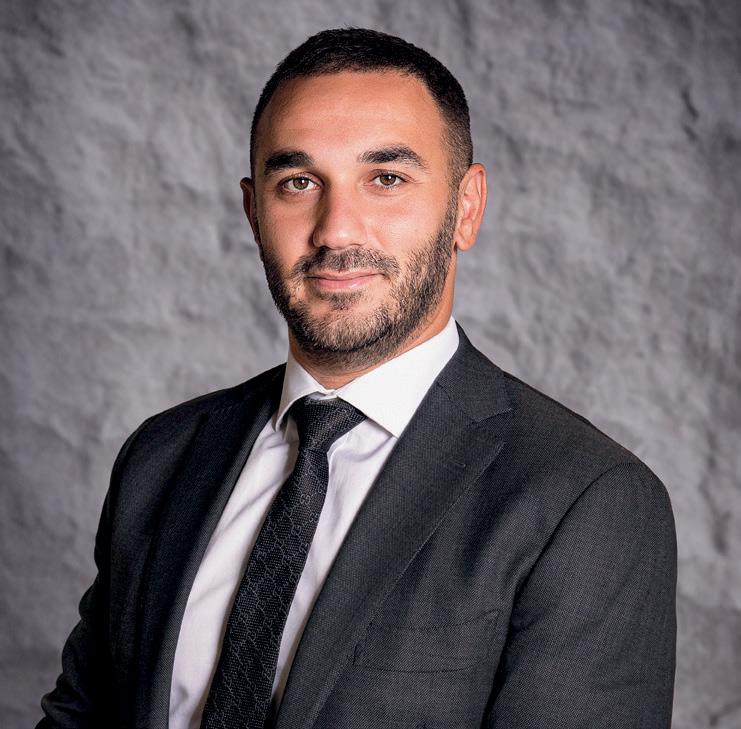



18
Big Project ME speaks to Versatile International’s Wajdi Marroun about the sourcing and installation of natural stone in line with a developer’s vision
14
The Middle East’s real estate market is expected to continue its upward trajectory in 2024, with strong economic growth, demand and limited supply expected to drive performance says CBRE’s latest report
Jason Saundalkar speaks to Michael Marti about decarbonising cement production in a post COP28 world through the use of new processes and technology
30 Event Review
The 2024 Energy & Sustainability Summit featured three keynote addresses, three panel discussions, two fireside chats and two presentations
36 Comment
Wilo ME’s Yasser Nagi on modern tools that are designed to improve pump efficiency and promote sustainable operations
40 Final Update
The RTA has announced the completion of construction works on roads, streetlights and rainwater drainage systems in residential areas in Dubai
1 MEConstructionNews.com | April 2024 CONTENTS April 2024
08 14 18 24 30 36
ANALYSIS FEATURES INSIGHT
08 The Briefing
region
James Cubitt MENA is celebrating 25 years in the region and is eyeing greater opportunities in the MENA
Big Picture
wrap-up
construction news
for the month
12 The
A
of the biggest international
stories
Market Report
In Profile Securing a Vision
24 In Profile Decarbonising cement production
Infrastructure in the spotlight

Welcome to another issue of Big Project Middle East (BPME)! The team and I have been quite busy since the year kicked off, putting together this fine publication each month, in addition to bringing you a diverse mix of events.
I’m immensely proud of the conferences that the BPME team produces, and this year’s Energy & Sustainability Summit broke new ground in terms of government participation - the event saw participation from five government organisations from Dubai and Abu Dhabi, in addition to several key private sector players from the construction and energy segments. If you missed it, you can watch recordings of the sessions on our web platform www.meconstructionnews.com.
Energised by the third successful showing of that event, the team and I moved straight onto an all new event in our calendar – the Critical Infrastructure Summit. As the name suggests, the conference will put critical infrastructure in the region into sharp focus, and I personally think this is the perfect time for such a summit, given the massive infrastructure development
taking place across the Middle East and North Africa.
Industry data says the region currently has more than US $3tn in projects in its development pipeline, concentrated around construction, power, transportation, and the oil and gas industry. Infrastructure is critical to the region’s ongoing success and the achievement of economic aspirations outlined by each countries’ respective ‘Vision’ plans.
The last few years have seen a number of fantastic infrastructure projects take shape, including: the Al Maktoum International Airport; Etihad Rail; the Riyadh Metro; the Kuwait Airport Expansion project, and many others. There’s also been significant investment into desalination plants – eight of the world’s largest now operate within the UAE and Saudi Arabia alone, and as the world moves towards a digital future, data centre development has also sky rocketed.
Taking all this into account, the Critical Infrastructure Summit will highlight trends, as well as development considerations and challenges associated with airports, data centres, seaports, rail projects and urban mobility. Read more about the event and do remember to register to join us on the day: https://2024.criticalinfrastructuresummit. com. See you there!
 Jason Saundalkar HEAD OF CONTENT
Jason Saundalkar HEAD OF CONTENT
jason.s@cpitrademedia.com
MEConstructionNews me-construction-news
2 April 2024 | MEConstructionNews.com WELCOME Introduction



MEConstructionNews.com
@meconstructionn
MEConstructionNews
me-construction-news
Group
MANAGING DIRECTOR Raz Islam raz.islam@cpitrademedia.com
MANAGING PARTNER Vijaya Cherian vijaya.cherian@cpitrademedia.com
DIRECTOR OF FINANCE & BUSINESS OPERATIONS Shiyas Kareem shiyas.kareem@cpitrademedia.com
PUBLISHING DIRECTOR Andy Pitois andy.pitois@cpitrademedia.com
Editorial
HEAD OF CONTENT Jason Saundalkar jason.s@cpitrademedia.com +971 4 375 5475
Advertising
SALES DIRECTOR Farhan Ahmed farhan.ahmed@cpitrademedia.com +971 4 375 5478
Design
ART DIRECTOR Simon Cobon simon.cobon@cpitrademedia.com
DESIGNER Percival Manalaysay percival.manalaysay@cpitrademedia.com
Photography
PHOTOGRAPHER Maksym Poriechkin maksym.poriechkin@cpitrademedia.com
Marketing & Events
EVENTS EXECUTIVE Minara Salakhi minara.s@cpitrademedia.com +971 4 433 2856
Circulation & Production
DATA & PRODUCTION MANAGER Phinson Mathew George phinson.george@cpitrademedia.com +971 4 375 5476
Web Development
WEB DEVELOPER Abdul Baeis abdul.baeis@cpitrademedia.com
WEB DEVELOPER Umair Khan umair.khan@cpitrademedia.com
FOUNDER Dominic De Sousa (1959-2015)
ON THE COVER Big Project ME talks to Wajdi Marroun about the sourcing and installation of natural stones in line with a developer’s vision Securing a Vision
A
4 April 2024 | MEConstructionNews.com
VERSATILE INTERNATIONAL'S WAJDI MARROUN, DISCUSSES THE SOURCING AND INSTALLATION OF NATURAL STONES IN THE REGION IN LINE WITH
DEVELOPER'S VISION
The publisher of this magazine has made every effort to ensure the content is accurate on the date of publication. The opinions and views expressed in the articles do not necessarily reflect the publisher and editor. The published material, adverts, editorials and all other content are published in good faith. No part of this publication or any part of the contents thereof may be reproduced, stored or transmitted in any form without the permission of the publisher in writing. Publication licensed by Dubai Development Authority to CPI Trade Publishing FZ LLC. Printed by Al Salam Printing Press LLC. CPI Trade Media. PO Box 13700, Dubai, UAE. +971 4 375 5470 cpitrademedia.com © Copyright 2024. All rights reserved.

Complimentary Register for free and

FINANCIAL
Government commits new capital to RAK Properties
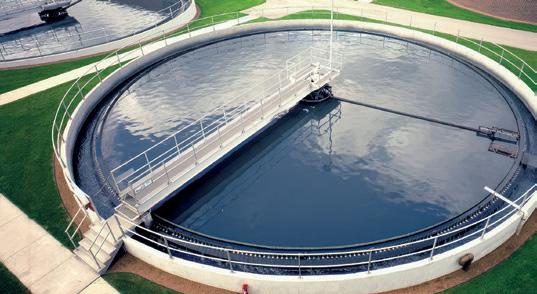
INFRASTRUCTURE
Works begin on Zuluf water treatment plant says Fisia Italimpianti

CONSTRUCTION
RTA to launch WO-RK coworking space at BurJuman metro station

INFRASTRUCTURE
Cooling contract worth $187mn awarded for Diriyah

INFRASTRUCTURE
Abu Dhabi’s Taweelah desalination plant begins operations

ANALYSIS: Construction costs in the Middle East set to rise by up to 7% in 2024

INTERVIEW: Sustainable growth

INTERVIEW: Building the Blueprint for a Sustainable Tomorrow

Next generation critical infrastructure will drive the diversification, growth and development of GCC countries
NOW 17 April 2024 Two Seasons Hotel / Dubai LEADERBOARD 728x90_PRINT.indd 1 2/13/24 10:24 AM 6 ONLINE April 2024 | MEConstructionNews.com LATEST NEWS FEATURES
REGISTER
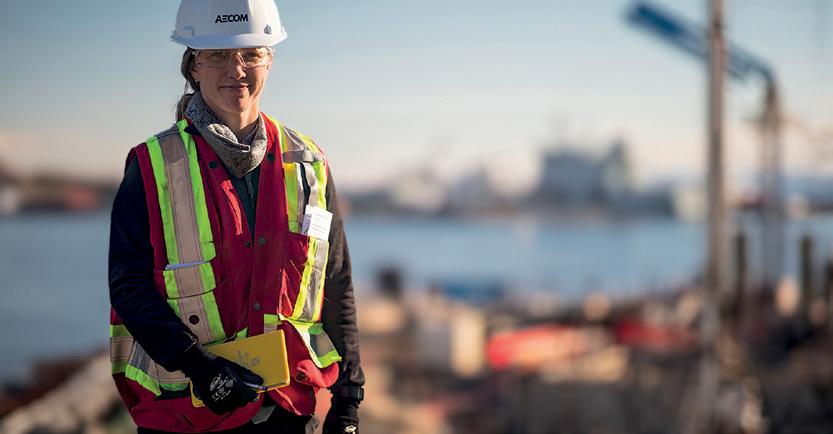


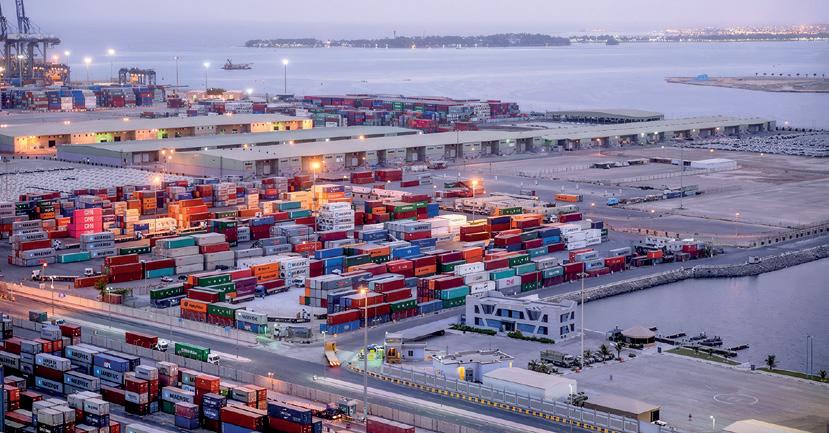

DIVERSITY
AECOM celebrates UN’s #InvestInWomen theme on International Women’s Day Achieving gender equality in all aspects of life is more crucial than ever if we want to create prosperous economies and a sustainable planet
PROPERTY
Eagle Hills International launches Bahrain JV
New entity backed by $4bn funding from Abu Dhabi titan and local investment consortium
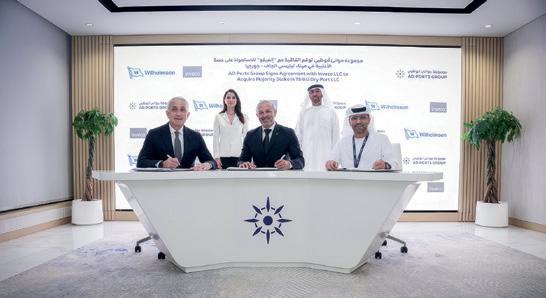
INFRASTRUCTURE
AD Ports Group inks deal for 60% stake in Tbilisi Dry Port

CONSTRUCTION
New beaches announced for Yas Bay Waterfront
CONSTRUCTION
Kingdom City sold for US $240mn Kingdom Holding Company will retain partial interest via new owner’s real estate fund

EVENT
LOGISTICS
Bahri begins build on new logistics centre at Jeddah Islamic Port Designed to cater to a broad spectrum of storage needs, Bahri Logistics Center features temperature-controlled areas and handling services
CONSTRUCTION
Deals worth US $2.6bn finalised for Sultan Haitham City Oman completes more than 35 development and partnership agreements for Phase One of the prestigious urban development

Heavy Equipment and Truck Show to take place in Dammam 18-21 Nov 2024

CONSTRUCTION
RIB Software survey reveals positive outlook for 2024
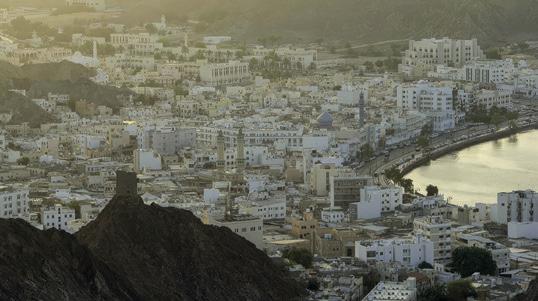
CONSTRUCTION
Oman to partner with ICC for new building codes
MEConstructionNews.com | April 2024 7 ONLINE MOST POPULAR FEATURED NEWS
REGISTER NOW
1 May 2024
UAE ED&I AWARDS LEADERBOARD 728x90_PRINT.indd 1 2/13/24 9:46 AM
Dubai /
JC MENA celebrates 25 years in the region
The firm says it will continue to prioritise sustainable solutions and client satisfaction and is eyeing greater opportunities in the MENA region
James Cubitt MENA (JC MENA) intends to boost its focus on innovative engineering solutions and integrating sustainability principles into all projects, in line with the UAE’s vision for a sustainable future. James Cubitt & Partners’ origins date back to 1947 in London and, this year, the firm’s regional subsidiary - JC MENA - is celebrating 25 years of operations in the region.
“Over the past quarter-century JC MENA has marked significant milestones as a construction consultancy company. Throughout this period, we have completed numerous iconic projects for our esteemed clients, consistently meeting deadlines and budgetary constraints, showcasing our ability to deliver high-quality work,” says JC MENA Director, Mohamed Abushady.
Since its regional debut 25 years ago, the firm has delivered a diverse range of successful projects,

April 2024 | MEConstructionNews.com 8
MIDDLE EAST
THE BRIEFING

including: the Hilton Garden Inn and Embassy Suites, Makkah KSA; Seven City, JLT Dubai; Al Reef Compound, Riyadh KSA; Mudon Arabella, Dubai; TBC Wave 2 (60 Schools in various locations), KSA, and the SEHA Disease Prevention and Screening Center, Abu Dhabi UAE.
“JC MENA’s involvement in infrastructure projects is one of the key achievements of the company over the past period such as masterplan developments, or stadiums, which demonstrate the company's capacity to handle complex assignments up to the expectation of the end user. Each of these projects stands as a testament to our firm's commitment to excellence and our ability to meet the diverse needs of our clients. We take pride in our track record of success and look forward to continuing to exceed expectations in the years to come,” adds Abushady.
He also notes that the firm is a trusted partner for several clients and enjoys significant repeat business. “Maintaining strong, long-term relationships with clients, underpinned by trust, reliability, and satisfaction is of paramount importance. Our firm places immense value on understanding clients' needs and aspirations. By fostering strong relationships and maintaining open communication channels, we tailor our solutions to precisely match their requirements, thereby delivering projects that exceed expectations,” he emphasises.
In addition to stepping up its focus on sustainable development, Abushady points out that the firm will stay abreast of evolving regulatory frameworks and ensure strict compliance with local laws and regulations, to mitigate risks and maintain a positive reputation. He states, “We will continue to prioritise client satisfaction by delivering high-quality engineering services that meet or exceed expectations, ensuring long-term relationships and repeat business. We are also excited to explore opportunities to diversify our service offerings and expand into new sectors or markets
within the UAE or internationally to broaden the consultancy's portfolio and revenue streams.”
1947
James Cubitt & Partners’ origins date back to 1947 in London
The firm has made a name for itself in the residential and educational sectors within the MENA region, and has delivered several key projects such as the Musaffah Gardens and Saraya R14 residential projects for the Al Nahda Group, Sharjah Majestic Tower and Khalidiya Shining Towers for Emirates Land Group, TBC Wave 2 Schools Project (60 Schools in various locations) for Vision Invest in Saudi Arabia, as well as Elite school in Knowledge Academic City, Medina.
Going forward, the firm is keen to explore greater opportunities in Saudi Arabia and has invested in a new office in the Kingdom in support of its aspirations.
“JC MENA recognises significant opportunities in the Saudi market, particularly in the realm of infrastructure development, commercial projects, healthcare facilities, and hospitality ventures.
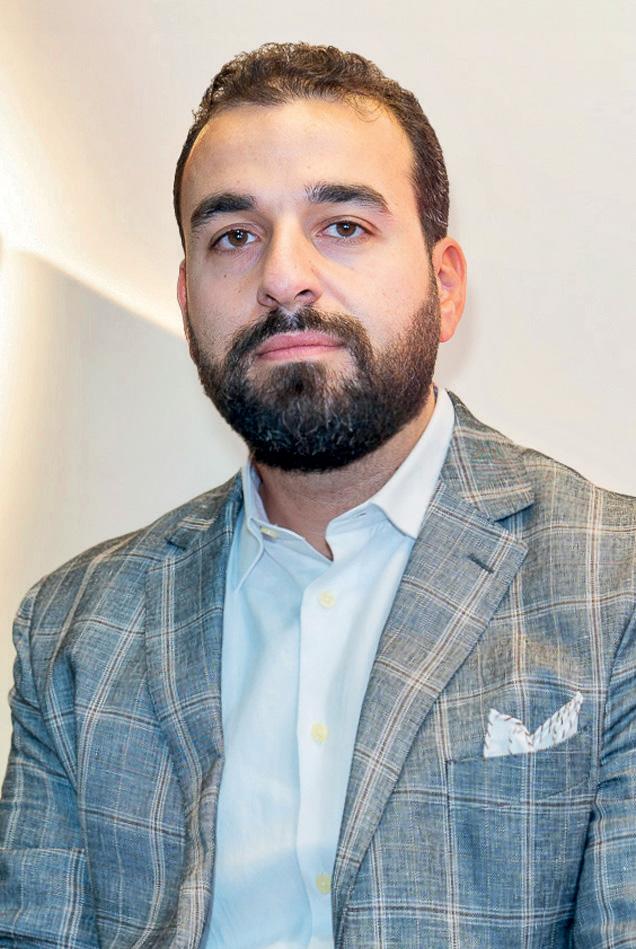
The Kingdom's Vision 2030 initiative presents a conducive environment for our firm to expand its presence and contribute to the nation's growth,” says Abushady.
“Our regional headquarters in Riyadh, Saudi Arabia serves as a strategic foothold to capitalise on these opportunities effectively. By establishing a local presence, we aim to strengthen our relationships with key stakeholders, better understand the unique intricacies of the market, and tailor our services to meet the specific needs and demands of clients in the region. The office enables us to provide timely and localised support, fostering stronger partnerships and enhancing our ability to deliver exceptional results.”
He adds, “In addition to our focus on residential and education segments, our expansion into the Saudi market opens doors to explore new sectors such as infrastructure, commercial developments, healthcare facilities, and hospitality projects. With our diverse expertise and proven track record in delivering high-quality engineering and consultancy services, we are wellpositioned to make a substantial impact across various segments in the Kingdom, contributing to its economic development and sustainable growth.”
Apart from the UAE and Saudi Arabia, the firm is also anticipating significant growth from several other regional markets. “JC MENA anticipates significant opportunities for expansion and growth in Nigeria, Egypt, and Libya, where we have already established branch offices. With our presence in these countries, we are well-positioned to capitalise on emerging projects and developments in the engineering and consultancy sectors.”
He concludes, “Our established local presence allows us to better understand the unique market dynamics, regulatory frameworks, and cultural nuances of each country, enabling us to provide tailored solutions that meet the specific needs of clients in these regions.”
9 MEConstructionNews.com | April 2024 THE BRIEFING
Driving success
Mohamed Abushady, JC MENA Director.
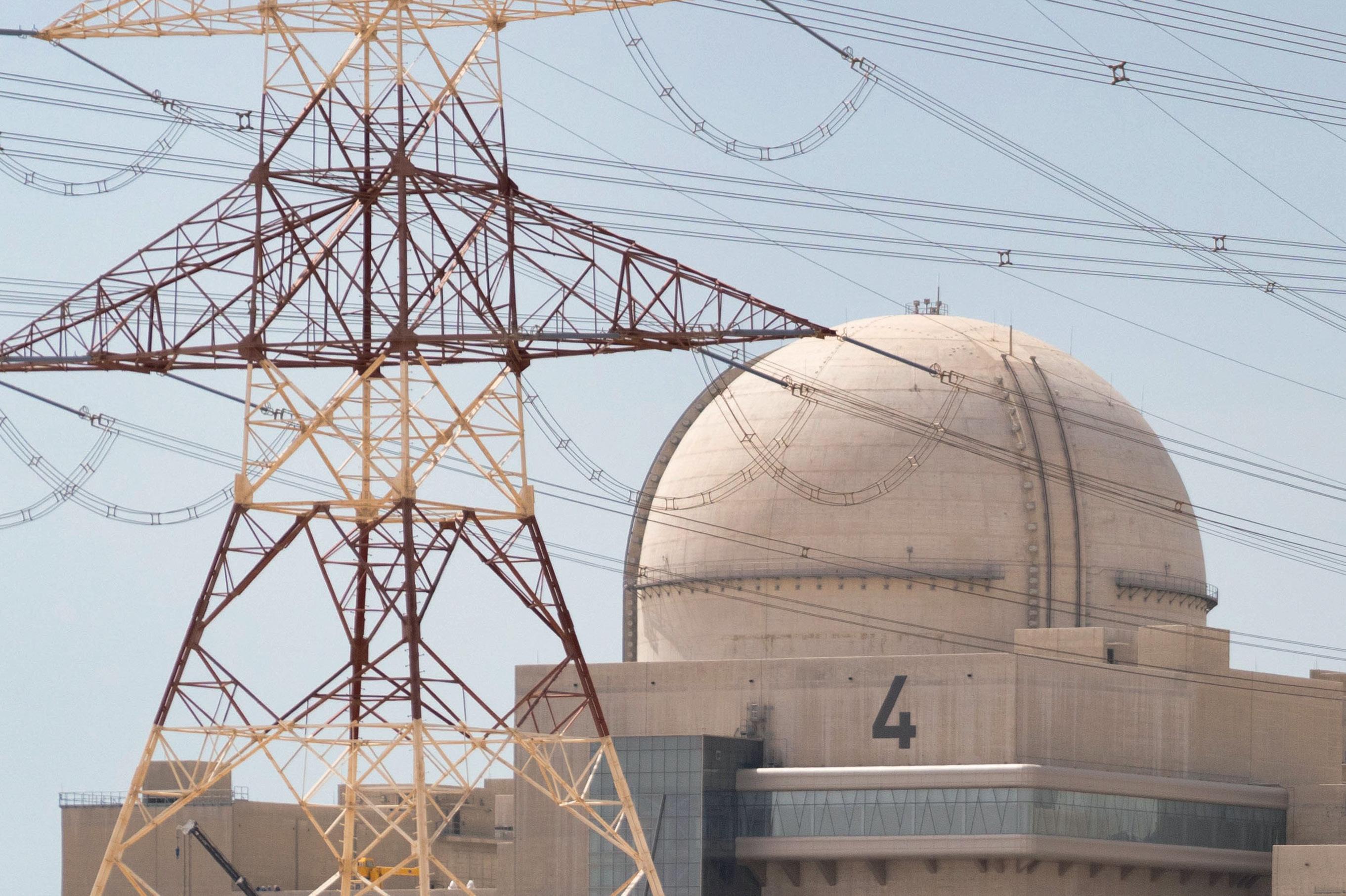
Unit 4 of Barakah Nuclear Energy Plant connected to UAE grid
UNITED ARAB EMIRATES
The four operational units of Barakah will soon provide up to 25% of the UAE’s electricity needs, supporting the decarbonisation of the UAE’s power sector
Nawah Energy Company has said that it has safely and successfully connected Unit 4 of the Barakah Nuclear Energy Plant to the UAE’s transmission grid. The firm is the operations and maintenance subsidiary of Emirates Nuclear Energy Corporation (ENEC).
Grid connection signifies the delivery of the first megawatts of carbon-free electricity from the fourth reactor of the nuclear energy plant, marking a pivotal moment in the nation’s clean energy transition and journey towards Net Zero by 2050. Unit 4 will add another 1,400MW of clean electricity capacity to power the national grid, representing another significant step forward towards fullfleet operations, further supporting the UAE’s efforts in enhancing grid stability and energy security through abundant around-the-clock zero-emissions electricity, said a statement from ENEC.
The Nawah teams at Barakah are said to have worked closely with the
Abu Dhabi Transmission and Despatch Company (TRANSCO), a subsidiary of Abu Dhabi National Energy Company PSJC (TAQA), who constructed the overhead lines to connect the Barakah Plant to the Abu Dhabi grid – ensuring the power generated at Barakah is safely, securely and reliably delivered to consumers across the country.
“We are proud to have achieved another critical milestone for the Barakah Plant, which stands as a testament to the UAE's leadership in the development of large-scale multiunit nuclear fleets. Grid connection of Unit 4 puts us well on the path to full-fleet commercial operations, and with that, the ability to generate 40TWh of clean, baseload electricity annually to drive our Net Zero economy, offering a competitive edge to many businesses, decarbonizing hard-to-abate industries, while presenting a global benchmark for the entire nuclear energy industry,” said His Excellency Mohamed Al Hammadi, Managing Director and Chief Executive Officer of ENEC.
April 2024 | MEConstructionNews.com 10
THE BRIEFING

Grid connection of Unit 4 solidifies the Barakah Plant's position as the cornerstone of the UAE’s Net Zero 2050 Strategy, contributing significantly to the nation's clean energy portfolio. It not only propels the UAE towards achieving its ambitious climate goals but also positions the country as a leader in nuclear energy and decarbonisation. The operational readiness of all four units underscores the UAE's commitment to diversifying its energy sources, ensuring the reliability and sustainability of its energy sector for the next six decades, the statement added.
The fourth unit is nearing the start of commercial operations. Following grid connection, Unit 4 will undergo the process of gradually raising power levels, known as Power Ascension Testing (PAT). The process will be continuously monitored and tested until maximum electricity production is reached, while adhering to all local regulatory requirements and the highest international standards of safety, quality and security. Each Unit has been connected
to the grid more efficiently than the previous unit, as institutional knowledge and experience are applied to each subsequent unit. Unit 3 was delivered four months faster than the Unit 2 schedule, and five months faster than the Unit 1 schedule, demonstrating the significant benefit of building multiple units within a phased timeline, ENEC explained.
Backed by the success of the Barakah Plant, ENEC is at the forefront of pioneering initiatives aimed at shaping the future of clean energy. ENEC's focus on advancing nuclear technologies, across large-scale PWR reactors through to Small Modular Reactors (SMR) and microreactors through the ENEC ADVANCE Program, aims to further strengthen the UAE's leadership in climate action and clean energy transition. This strategic direction not only amplifies the UAE's contributions to global decarbonization efforts but also showcases the potential of advanced nuclear technologies in meeting the world's growing energy needs sustainably, the statement concluded.

11
MEConstructionNews.com | April 2024 THE BRIEFING CONTACT Messe Berlin GmbH Messedamm 22 · 14055 Berlin Germany T +49 30 3038 3131 innotrans@messe-berlin.de THE FUTURE OF MOBILITY BigProjectMiddleEast_InnoTrans2024_95x237mm_en.indd 1 28.03.2024 08:58:18 Critical milestone His Excellency Mohamed Al Hammadi, Managing Director and Chief Executive Officer of ENEC.
01 UNITED STATES
US $1bn climatefocused action plan announced
New York authorities have announced the release of a new Green Economy Action plan, which includes almost US $1bn of investments into climatefocused construction and infrastructure projects. The plan was announced by New York City Mayor Eric Adams, along with New York City Economic Development Corporation (NYCEDC) President and CEO Andrew Kimball
Billed as a ‘first-of-its-kind’ scheme, the plan serves as a roadmap for New York City’s (NYC) fight against climate change and its goal of a greener economy.

04 POLAND
Bechtel awards contracts for construction of Poland’s first nuclear facility
The first procurement contracts for the construction of Poland’s first nuclear plant have been awarded by Bechtel. The firm is working alongside Westinghouse Electric Company to oversee the design and construction of the energy facility.
According to the firm, it will deliver three AP1000 reactors for Polskie Elektrownie Jądrowe at the LubiatowoKopalino site in Pomerania. The plant is being developed at a cost of US $20bn.
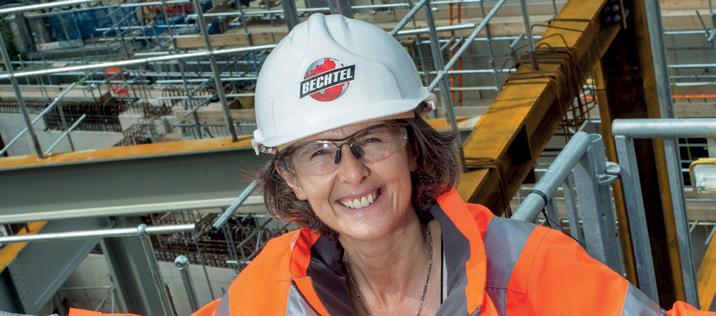

02 UNITED STATES Breedon enters US market with $300mn acquisition of BMC
Breedon has acquired readymix supplier BMC Enterprises as part of its entrance into the North American market, the company has announced. The deal was valued at US $300mn according to Breedon, which specialises in construction materials and quarrying.
BMC, formerly Breckenridge Material Company, is a supplier of ready-mixed concrete, aggregates and building products. Headquartered in St Louis, Missouri, the firm turned over $179mn last year and has more than 400 million tonnes of reserves and resources.

AD Ports Group inks deal for 60% stake in Tbilisi Dry Port
A purchase agreement has been signed between AD Ports Group and Inveco LLC, which will see the former company acquire 60% ownership in the Tbilisi Dry Port, which is said to be a new custom-bonded and rail-connected intermodal logistics hub in Georgia.
Currently owned by Inveco LLC and Wilhelmsen, the project is expected to be operational by Q4 2024. It is expected to serve as a key logistics hub situated along the important Middle Corridor – an emerging trade lane linking manufacturing hubs in Western Asia to consumer markets.
03 SPAIN
Madrid’s airport to undergo $2.6bn expansion
Madrid’s Adolfo Suárez-Madrid Barajas Airport is to undergo an expansion, with the goal of enhancing its role as Europe’s primary gateway to Latin America. Operations at the airport are expected to bolster the country’s connection to Asia.
Announcing the investment initiative, potentially totalling US $2.6bn, Spain’s Prime Minister, Pedro Sánchez said, “This will be the airport with the greatest growth potential in Europe.”
The sum represents the largest infusion of funds into Spanish airport infrastructure in the past decade.

06 KUWAIT
Funds to be allocated to complete Mubarak Al Kabeer Port in Kuwait
Kuwait has announced plans to allocate US $604mn to the Ministry of Public Works for the completion of Mubarak Al Kabeer Port project during FY 2024-2025. The project, which is being built on an area of 1,161ha will accommodate 24 berths and will have a capacity of 8.1m containers. The amount allocated to the development under the country’s capital projects expenditures reflects the importance attached to its early completion, especially since there was an initial hiatus in the issue of competitive tenders.

12 April 2024 | MEConstructionNews.com 02 01
THE BIG PICTURE
05 GEORGIA
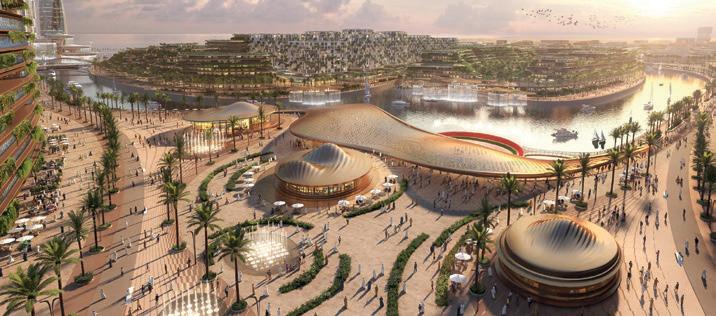
Oman’s MoHUP announces new $1.3bn waterfront project
Oman’s Ministry of Housing and Urban Planning (MoHUP) has announced plans for a concept-led waterfront project, Al Khuwair Muscat Downtown and Waterfront Development, to be built in the capital at a total investment of US $1.3bn. Spanning 3.3m sqm, the project has been designed by Zaha Hadid Architects (ZHA).
The sustainability-led design is said to prioritise the well-being of residents and visitors, and will redefine urban living in Oman at a time when Muscat’s population is anticipated to almost double from 1.5m to 2.7m inhabitants by 2040.
08 INDIA
Three fabs to be developed in India at a cost of $15.2bn
The construction of three semiconductor fabs has been approved by the Indian government. The three units include the construction of a chip factory in Dholera, Gujarat. The fab is expected to produce high performance computer and power management chips.
The second fab will be developed by Tata Semiconductor Assembly and Test Pvt Limited and will serve the automotive, electric vehicle, consumer electronics and telecoms markets. The third will focus on chips for the consumer, industrial, automotive and power sectors.


09 INDIA
Ferrovial purchases 24% stake in infrastructure firm
Ferrovial has invested $802.3mn for a 24% stake in IRB Infrastructure Trust in India. IRB is an investment vehicle that integrates road concessions and construction and has a portfolio of 12 toll road concessions in India.
According to a report, Ferrovial is acquiring the stake from affiliates of GIC, which currently own a 49% stake of IRB Infrastructure Trust. After the transaction is closed, GIC’s affiliates will retain a 25% stake in IRB Infrastructure Trust and IRB Infrastructure Developers will maintain its current 51% stake.
13 MEConstructionNews.com | April 2024 09 03 05
THE BIG PICTURE 06 07 04
07 OMAN
08
Industry Outlook

MIDDLE EAST
2024 Regional Outlook
The Middle East’s real estate market is expected to continue its upward trajectory in 2024, with strong economic growth, demand and limited supply expected to drive performance says CBRE’s latest report
Economic growth in GCC countries showed fragmented performance in 2023, with the average rate of growth registering at only 0.6% for the year, down from 6.0% in 2022. This softer headline growth rate in 2023 has largely been driven by a number of GCC countries’ oil GDP rates of growth slowing or receding into contractionary territory, averaging a decline of 3.1%. This data is in contrast to GCC countries' non-oil GDP growth rates, which have actually increased on average by 3.1%.
In 2024, GDP growth in GCC countries is expected to strengthen, with headline growth forecast to reach 2.9%. Whilst oil GDP is expected to recover with growth set to register at 2.2%, the non-oil sector is expected to show a stronger rate of growth of 2.9% over the same period.
The rate of inflation in GCC countries fell from 3.7% in 2022 to 2.2% in 2023, a marked difference from the global rate of inflation, which stood at 6.1% in 2023. In 2024, the headline rate of inflation across the six GCC countries is expected to increase marginally to 2.4%, this is on the back of higher forecast inflation rates in Bahrain and Oman. In both countries, in 2023, the rates of inflation were relatively muted and the 2024 forecasts sit comfortably below their historic averages.
In 2024, in all other GCC countries, the rates of inflation are expected to ease.
Estimates indicate that employment levels increased by 3.1% in 2023 across GCC countries. Although it is important to note that higher frequency employment data across these countries points to a stronger rate of employment growth than has been estimated. Looking ahead into 2024, forecasts
14 April 2024 | MEConstructionNews.com
MARKET REPORT
Source: CBRE Research, Oxford Economics
show that the headline rate of employment growth in GCC countries is expected to slow to 1.8%. Saudi Arabia, the UAE and Bahrain are expected to register the strongest rates of employment growth at 3.6%, 3.1% and 2.4% respectively. The only location where forecasts indicate that there will be a contraction in employment in Qatar, where the total is expected to decrease by 1.1%.
Although there are economic headwinds at both global and national levels, the latter mostly pertaining to the oil related activities, we note that activity in the non-oil and particularly in real estate sectors remains buoyant across GCC countries. Where, as at 2024, the total value of real estate projects currently planned or under construction currently stands at an estimated $1.68tn, up from $1.38tn a year earlier. Saudi Arabia accounts for 63.1% of this total or some
$1.06tn, followed by the UAE, which at $409bn accounts for 24.4% of the total. Bahrain, Kuwait, Oman and Qatar share 1.3%, 3.2%, 5.2% and 2.9% of the total, respectively.
The investment and development of the built environment, is a core part of the diversification strategies of GCC countries. The increased levels of investment showcase the seriousness of the desire to achieve such goals.
In the long term, this will support the growth of tourism, financial and business services, logistics, manufacturing, healthcare, education and other sectors. As commendable as much of this development is and will be, it must be done with the continued development of soft infrastructure and regulations in each of these countries. Without the development of this soft infrastructure and the easing of regulations, the success of the built environment may be constrained in the long term.
RESIDENTIAL OUTLOOK
Price performance in the GCC’s residential sector has almost uniformly been positive over the course of 2023, with only villas in Bahrain and apartments in Jeddah seeing prices decline marginally. Whilst the direction of price changes has converged towards a largely positive territory, we continue to see a significant polarisation in the rates of growth witnessed, something we expect to see continue.
Looking at Bahrain in 2023, apartment rates registered an increase. It is anticipated that with the continued addition of quality stock and attracting regional investment, there will be steady growth in rates for 2024. Villa sales rates, based on plot area, which are predominantly driven by local market demand, are likely to remain relatively stable.
In Saudi Arabia, we expect that price performance will continue to be fragmented
15 MEConstructionNews.com | April 2024 MARKET REPORT
COUNTRIES INFLATION, YOY% CHANGE 2023 2024 2025 6.0% 5.0% 4.0% 3.0% 2.0% 1.0% Bahrain Kuwait Oman Qatar Saudi Arabia UAE World GCC COUNTRIES GDP, YOY% CHANGE 2023 2024 2025 6.0% 4.0% 2.0% 0.0% -2.0% -4.0% Bahrain Kuwait Oman Qatar Saudi Arabia UAE World
GCC
over the course of the year, both across cities and typologies. Moreso, we forecast that average price growth in Riyadh will materially outperform other key cities and on the whole, we also expect transaction volumes to stabilise in 2024 after two consecutive years of declines.
The UAE continues to be the only market which has recorded both price and transaction volume growth in 2023. In Abu Dhabi, we expect that transaction volumes will continue to grow over the course of 2024, with new high-end and prime stock expected to underpin stronger rates of price growth on average. Existing and dated stock, on the other hand, is likely to materially underperform the market. In Dubai, we expect transaction volumes to decrease, but only marginally. Price growth in the apartment and villas segments of the market will continue, however, we expect this rate to moderate somewhat over the course of the year.
OFFICES OUTLOOK
In 2024, whilst we expect the robust level of performance seen in 2023 to continue, global economic headwinds and lack of stock in key markets may hamper market activity.
In Bahrain, Prime and Grade A rents remained stable in 2023, as occupancy increased by 4.0 percentage points, with new supply remaining relatively constrained. With supply expected to increase by 1.1% in 2024, amidst the continuing flight to quality trend, we expect that rental rates will continue to edge down over the course of the year.
In Saudi Arabia, occupier activity will remain relatively concentrated within Riyadh, where, given the elevated demand levels from both national and international occupiers, we saw the headline occupancy rate reach 98.1% in Q4 2023. The lack of availability of quality stock, the very limited amount of imminent
future supply and elevated pre-leasing activity are expected to continue to drive performance within Riyadh’s occupier market in the year ahead; that being said, the rate of growth will taper off. As for Jeddah and the Eastern Province, a slowdown in the rate of rental growth is expected over the upcoming year.
Occupier activity in the UAE is likely to remain resolute in the year ahead. Performance within Abu Dhabi’s occupier market will remain relatively strong. We forecast that Prime and Grade A assets will continue to outperform the market, given the scarcity in supply and rising demand for high-quality assets. In Dubai, with the lack of existing quality stock, elevated demand levels and the limited number of developments in the pipeline, which are seeing strong preleasing activity, we expect that rental rates will continue their upward trajectory moving forward, however at a slower rate than the year prior.
16 April 2024 | MEConstructionNews.com MARKET REPORT
OFFICE RENTS, US$ PER SQUARE METRE PER ANNUM AND YOY% CHANGE, 2023 700 600 500 400 300 200 100 BahrainPrime BahrainGrade A RiyadhPrime RiyadhGrade A RiyadhGrade B JeddahGrade A JeddahGrade B DammamGrade A DammamGrade B KhobarGrade A Abu DhabiPrime Abu DhabiGrade A Abu DhabiGrade B DubaiPrime DubaiGrade A DubaiGrade B -0.3% 0.0% 20.7% 13.0% 22.2% 19.7% 1.0% 7.4% 7.9% 7.2% 0.5% 3.4% 4.8% 8.0% 13.3% 18.2% AVERAGE SALES PRICES, YOY% CHANGE, 2023 APARTMENTS VILLAS 20.0% 16.0% 12.0% 8.0% 4.0% 0.0% -4.0% Bahrain Kuwait Oman Qatar Saudi Arabia UAE World
Knowledge. Resources.
The value of ACI membership has never been greater. Our top fi ve benefits for the region are:
• Webinars and on-demand courses
• ACI Practices (includes all ACI guides and reports)
• Concrete International and ACI Journals
• Connections with over 30,000 global concrete industry professionals
• Discounts on ACI’s Codes and Specifications (including SI Units)
ACI membership is your most valuable resource in the concrete industry. Join the premier world community dedicated to the best use of concrete.
concrete.
“ACI is the premier organization for the concrete industry.
Becoming an active member will enhance anyone’s professional career.”
—John F.
ACI Membership means high value.
ACI members know it.
Join now at concrete.org.
17 MEConstructionNews.com | April 2024

18 April 2024 | MEConstructionNews.com

Securing a Vision
WAJDI MARROUN, MANAGING DIRECTOR OF VERSATILE INTERNATIONAL TALKS TO BIG PROJECT MIDDLE EAST ABOUT THE SOURCING AND INSTALLATION OF NATURAL STONES IN THE REGION IN LINE WITH A DEVELOPER’S VISION, MARKET CHALLENGES AND HIS FIRM’S PLANS FOR THE FUTURE

19 MEConstructionNews.com | April 2024
IN PROFILE Versatile International

ersatile International was established to support the vision of destination-scale development projects in the Middle East and beyond with regards to natural stone sourcing and installation. The firm offers consultancy, procurement management and installation oversight, and says it is committed to taking signature projects from vision to reality.
As the professional services arm of the Versatile Group, the firm says it is able to draw from significant accumulated experience of asset development, stone selection, sourcing and installation. The firm says its service offering enable it to act as an integrated extension for a project’s asset development team with an absolute focus on delivery: on-time, on budget and with minimal operational risk.
Here, Big Project Middle East talks to Wajdi Marroun, Managing Director of Versatile International about the firm’s business in the region, the market’s appetite for stone along with challenges, and the firm’s plans for the future.
How did Versatile International fare in 2023? What was your
biggest achievement last year?
2023 was a growth year for Versatile International; we are currently working on more than 50 projects in Saudi Arabia and the wider Middle East and have a number of new contracts pending for early 2024.
I think our biggest achievement has really been in expanding interest in and appetite for our unique offer. There’s always a certain degree of resistance when something new is introduced to the market and the Versatile International model is very different from the traditional way of managing natural stone design, sourcing, procurement, and oversight. The fact that clients are recognising the value, expanding the scope of their business with us, and recommending us to others is a clear sign that the model does add value to destinationscale developments and sets us up for a very solid start to the New Year.
Share an overview of the Middle East’s appetite for natural stones –where do you see opportunities?
I think natural stone is fast becoming a construction material of choice across the world, not just in the Middle East. Apart from the aesthetic appeal and local authenticity that stone brings to large-scale projects, it is increasingly being recognised as a very sustainable material and one that, with recent technological advances, is a great deal more versatile than it’s often credited for.
Procurement challenges Traditional methods of stone procurement are hampered by competing priorities: asset developers are motivated by a vision, while suppliers and installers are motived by profit margins, the firm notes.
50
Versatile are currently working on more than 50 projects in Saudi Arabia and the wider Middle East

In the region, I think that the biggest opportunity lies in local sourcing. Procuring stone from local quarries not only adds the local flavor to a development, it also significantly reduces the supply chain risk associated with procuring more exotic stone from overseas. The challenge, especially for the destination-scale projects that we work on, is in identifying quarries that have the right grades of stone at the volumes that are required. For example, the amount of material for the public areas of Diriyah alone is equal to covering 100 football pitches. Achieving consistency and assuring quality at those volumes is not easy. That’s why we are working in Saudi Arabia to identify and certify local quarries for Riyadh limestone in order to meet demand for current and future developments.
What are some of the trends Versatile International is seeing in the market?
Stone selection is a complex undertaking and depends very much on the purpose for which the material is going to be used. Density, water absorption, tensile strength, uniformity, and durability are just a few of the factors that we review when testing selected stone for a project to ensure that the finished installation matches the developer’s vision. Volume and budget are also major factors. The cost of a block of travertine, for example, can vary widely depending on the grade of the material. Understanding these variables is essential if developers are going to build to budget and avoid cost overruns down the line.
Certain stones are always popular – marble, for example, has long been the material of choice for high-grade decorative interiors, while harder stones like granite tend to be preferred for outdoor installations. Where the variety comes is in the textures and patterns of the stone. Even granite is available in a wide variety of shades and textures, which gives designers a lot to work with.
We are certainly seeing a preference for local stone wherever possible, especially for outdoor and large-scale public areas. Where material has to be sourced internationally, we are seeing a growing preference for using different types of stone together to produce a more
20 April 2024 | MEConstructionNews.com
IN PROFILE

variable and aesthetically pleasing effect. This, of course, also affects factors like adhesives, finishing, and maintenance, which is why it’s increasingly important to use a specialist stone consultant to ensure that the finished effect matches the original vision of the design.
What is the USP that Versatile International offers clients? How is the firm disrupting the traditional model of stone management?
The Versatile International model is designed specifically to remove risk from the natural stone construction process. We developed the model because we recognise that the traditional model of procurement is broken. The number of players in the supply chain – contractors, agents, suppliers, manufacturers, quarries, and so on – makes the system very vulnerable to manipulation. While the traditional model is intended to push risk downstream, what it actually does is increase risk to the developer through a lack of transparency and reduced oversight and control of material quality.
Versatile International is not a stone supplier. We work with our clients to get stone right from the start. That means reviewing designs, advising on obtaining stone that is fit for purpose, overseeing procurement, managing quality control at the source, and finally overseeing installation to ensure realisation of the design vision. We have no conflicts of
interest because we are not part of the supply chain itself. This means we put the asset first and focus our efforts on ensuring that the right material is available onsite in the right volume at the right time and installed in the right way, to deliver projects within their design and budget parameters. We specifically cater to the needs of destination-scale developments like giga-projects and large-scale mixed-use projects. In these types of projects, even a small variation in quality or cost at a unit level can have a significant impact on the project as a whole, simply as a result of the scale and complexity at which they operate. To our knowledge, there is no other company with an equivalent offer at the scale and depth of first-hand expertise that Versatile International is able to provide.
How does Versatile International works with clients, and how are stones evaluated?
It all begins with design. Architects and designers are not natural stone experts – they look at aesthetics and uniformity to formulate a vision for the project. However, stone is a natural and highly variable product. To achieve a seamless, uniform expanse of stone across a large interior space requires careful attention to the type of material used and the grade of stone required. The alternative is to risk a large amount of waste from
3
In early March 2024, Versatile renewed its contract with the Diriyah Company for an additional three years
discarding stone that has flaws or variations that don’t match the design. We advise on the stone selection, make alternative recommendations where appropriate, and then test the material to ensure that it’s fit for purpose before the procurement process begins.
Once the selection is finalised, we work with the client to develop the procurement documents, identify the right suppliers who can meet our requirements for volume and quality, and assess the tender submissions. Because we work for the asset, not the contractors or suppliers, we are able to do this with no conflict of interest at all.
We have quality management professionals to inspect procured material at the point of production, so that the client can be assured that the material shipped is up to specification. We also dry lay at the point of production to develop installation plans and ensure fitness for purpose.
Bringing rigor and expert oversight to the whole process right from the start is important to ensure that projects are delivered on time, on budget. An estimated 30% of construction budgets globally is spent on rework – essentially correcting errors and shortfalls that Removing risks The firm says its model is designed around removing risks from the natural stone construction process, in response to a realisation that the traditional procurement process is broken.
Finally, we oversee installation to make sure that the contractor fully understands and adheres to the installation plan and that the final installation meets the original design specifications.
21 MEConstructionNews.com | April 2024 IN PROFILE

could have been identified at the design stage before entering into supplier contracts. Our process brings the client closer to the supply chain, enhancing transparency and keeping the needs of the asset front of mind at all times.
Has there been an evolution of attitudes towards materials and project quality? What are clients eager to achieve on their projects? There has certainly been an evolution in attitudes to working with stone consultants as the value of the offer becomes more apparent. Ultimately, we would like to see developers engage stone consultants in the same way that they engage designers and architects – as an essential component of the project planning and design team. I think there’s still a way to go there. Ultimately, clients’ needs are consistent – achieve the vision of the project on time, on budget to the right standards of quality. What is changing is the use of technology to pre-visualise installations and track project progress. I think there is also a growing recognition that traditional project management and procurement models are not necessarily the best choice for non-traditional developments.
What are some of the issues you have noticed from selection all the way to maintenance? It usually comes down to the wrong
100 The amount of material for the public areas of Diriyah alone is equal to covering 100 football pitches
We specifically cater to the needs of destination-scale developments like giga-projects and large-scale mixeduse projects. In these types of projects, even a small variation in quality or cost at a unit level can have a significant impact ”
material being delivered to the site –material that is sub-standard in terms of quality or otherwise not fit for purpose. Stone is not a uniform material like concrete. If you make a mistake with stone, there’s no easy fix. You either have to replace it, which compromises delivery and budget parameters, or live with it, which compromises the integrity of the vision. That’s why is so important to get stone right from the start.
The other main area of risk is in installation. Contactors tend to value workplace efficiency over realising the vision of the asset. If the stone you have procured is not installed in line with the work plan then you have the same problem – replace it or live with it. That’s why we oversee the installation and provide the necessary training to contractors to ensure that the final product matches the original vision as laid out in the design.
What are some of the firm’s key projects in the GCC region to date?
Because we work exclusively with destination-scale developers, a single client can involve dozens of different projects for which we provide a wide range of services, from simple consultancy to full-scale end-to-end project management and governance.
We are currently involved in more than 50 different projects in Saudi Arabia and across the Middle East, from public areas to hospitality, cultural and
commercial assets. This involves material sourcing across the board, from kerb and gutter for roads to paving in public areas to high-end hotel interiors for five-star hotels, museums, libraries, and residential and commercial properties.
We’ve also been heavily involved in identifying and developing local quarries in Saudi Arabia to ensure that the assets have an authentic local character and minimise transportation costs.
What are the firm’s plans going forward?
What we have realised since establishing Versatile International is the supply chain challenges associated with natural stone are not limited to that material. Our model has the flexibility and potential to be applied to many different areas of the construction sector and even, perhaps, beyond that sector.
In 2024, we’re planning a JV agreement to combine consultancy, manufacture, and warranty services in another area of construction, and are receiving a great deal of interest in that offer.
We are also expanding our operations into the wider Middle East region working with large-scale developers who recognise the value of the model, and are keen to apply it to more disparate projects across their regional operations.
Versatile International is committed to this region and we are very confident that 2024 will be another growth year for the company.
22 April 2024 | MEConstructionNews.com
IN PROFILE
Saudi portfolio Since beginning with Diriyah in January 2020, the firm has consulted on over 50 assets, including public areas, heritage centers, high-end hotels, libraries, museums and residential properties.

1975
BY BUILDING THE FUTURE Since
eccgroup.ae

April 2024 | MEConstructionNews.com 24


Decarbonising the world’s most preferred building material
MIDDLE EAST
Jason Saundalkar speaks to ABB Process Industries’ Michael Marti about decarbonising cement production in a post COP28 world through the use of new processes and technology
According to the World Green Building Council, buildings are currently responsible for 39% of global energy related carbon emissions: 28% from operational emissions, from energy needed to heat, cool and power them, and the remaining 11% from materials and construction (embodied carbon).
As the world steps up its focus on decarbonisation in the journey towards a Net Zero future, it is absolutely crucial to tackle both operational emissions and embodied carbon, however, the latter is perhaps a more pressing immediate issue. This is because the greenhouse gas emissions (GHGe) from materials and construction are being released into the atmosphere right now, whereas operational emissions from a building will be spread over the structure’s entire lifecycle, which is a far longer period of time.
As per the Portland Cement Association, the manufacture of cement produces about 0.9-pounds of CO2 for every pound of cement. The association also notes that since cement is only a fraction of the constituents
in concrete, manufacturing a cubic yard of concrete (roughly 3,900lbs) is responsible for emitting about 400lbs of CO2. Today cement remains one of the world’s most preferred and used building material, which means it’s critical to find ways to reduce emissions associated with its manufacturing.
Here, Jason Saundalkar, Head of Content at Big Project Middle East speaks to Michael Marti, Global Manager, Business Line Growth Industries, ABB Process Industries about decarbonising this segment of the built environment in a post COP28 world.
What are some of the new regulations/targets that cement manufacturers have had to contend with in the last two years? Did COP28 result in any new mandates/ targets that cement producers now have to adhere to?
Cement remains the world’s preferred building materials, however, increasingly stringent greenhouse gas (GHG) emissions targets mean the cement industry must reduce CO2 emissions. The cement and concrete industry have established new targets to lower and
25 MEConstructionNews.com | April 2024
INTERVIEW
even eliminate emissions, such as those set by the Global Cement and Concrete Association (GCCA). These targets aim for a 20% reduction of CO2 per metric ton of cement and a 25% reduction of CO2 per cubic metre of concrete by 2030 compared to 2020 levels. The GCCA calls for complete decarbonisation by 2050.
During COP28, similar initiatives to help decarbonisation through coordination between nations were set. The idea is to collaborate on measures such as policies, regulations and technologies to help reduce the cost of future investment in decarbonisation. ABB is working with customers to develop various solutions and technologies that can assist in the industry’s transition. We have established partnerships that drive change through innovation and digitalization.
For instance, ABB and Coolbrook’s RotoDynamic technology (which replaces fossil fuels with renewable electricity) has been developed with the aim of cutting carbon emissions by up to 2.4bn tons annually. Additionally, ABB and Captimise have joined forces to support the cement industry in planning carbon capture, storage and utilisation (CCUS) projects by providing technology agnostic front-end engineering and design (FEED) studies and a smallscale trial facility to allow testing of selected carbon capture technology.
With over 60 years of demonstrated experience in automation and the adoption of Information Technology (IT) into Operation Technology (OT), ABB takes the ‘power of integration’ to the next level with reliable, secure, integrated systems that are easy to use and maintain. The ABB plant-wide automation strategy searches for the optimal operation point, while maximising product quality and productivity, at the lowest energy consumption and least environmental impact.
Generally speaking, were any new targets/mandates announced at COP28 that the built environment now has to account for with regards to decarbonisation/GHGe reductions? In line with GCCA’s actions over the

last two years and COP28, we see the development of carbon capture and storage increasing, greater use of alternative energy and the adoption of new materials and technology. These are all levers being used to cut emissions. For the built environment, the most urgent call to action is efficient use of energy and work with the universal adoption of Net Zero emissions buildings by 2050. At ABB we believe that our decarbonising solutions will be part of the answer to these emission reduction ambitions.
Which part of the cement production process is the most polluting in terms of GHGe? What can be done to make this part of the process less polluting? Clinker accounts for approximately 90% of the emissions released in cement production, making it a high priority for industry players to address – cement producers can consider substituting clinker with alternative materials in a bid to decarbonise the industry. Another challenge is energy-related emissions. Players are exploring ways to reduce fossil fuel consumption and maximise usage of alternative fuels, and newer technologies such as kiln electrification. At a local level, cement could lose share to more sustainable alternative materials, such as cross-laminated timber (CLT).
What role can technology play in reducing emissions/decarbonising the production of cement? How much more efficient can the process be made, and what are the expected GHG emission reductions that can be expected?
Technology will play a key role in reducing emissions for the cement industry. For example, ABB Ability Expert Optimizer and ABB Ability Knowledge Manager has been installed at customer cement plants worldwide, with proven impacts for enhanced productivity, streamlined processes, reduced maintenance and energy savings. Another example is ABB Ability Asset Performance which is an integrated suite of solutions for all asset performance management stakeholders that provides visibility to reliable data and information that support recommendations for actionable decisions.
Typical improvement values delivered by ABB to users of ABB Ability Expert Optimizer include up to 50% use of alternative fuels, 1%-3% recovery in product, up to 30% reduction in consumables, up to 8% increase in throughput, up to 50% reduction in quality variability and up to 10% reduction in emissions levels. The opportunity is to develop operational advances and technological innovation to decarbonise in the coming decades.
2050
The GCCA is calling for complete decarbonisation of the industry by 2050
When it comes to circularity in cement, environmental regulations are getting tougher each year. The more stringent they become, the more money is spent on waste processing, disposal and supervision. ABB technologies in environmental measurements and monitoring, process control and optimisation, will enable cement producers to increase operational efficiency, as well as improve environmental safety.
ABB also helps to safely utilise waste products as an energy source through incineration. The incineration can take place in the kiln or pre-heater as a supplementary fuel. This reduces the cost and consumption of primary fuel. ABB’s expertise and experience helps cement producers to maintain stable combustion conditions, while increasing the use of a huge variety
26 April 2024 | MEConstructionNews.com INTERVIEW
Industry leader Michael Marti, Global Manager, Business Line Growth Industries, ABB Process Industries.
of waste products. In partnership with our customers, ABB helps in moving them with moving towards their goal of zero fuel costs.
What potential low emission alternatives are there to cement that the construction sector can turn to? Is ABB investing in R&D into such a replacement material?
As mentioned, by partnering with Coolbrook and Captimise ABB has ventured into the R&D space. Aligning with our cross-industry sustainability campaign of the same name, we are looking to make ‘Real Progress’ when it comes to decarbonising solutions for the cement industry. Coolbrook’s RotoDynamic Heater (RDH) has the potential to reach temperature levels of 1700°C - compared to around 600°C in competing electric alternatives – without burning fossil fuels, enabling it to replace fossil-fired furnaces and kilns with electric heating during the production of cement. RDH can be used to replace around 50% of fossil fuels used for process heating. When it comes to implementing CCUS technologies in a cement plant, the total need for electrical energy use
11% Materials and construction are currently responsible for 11% of global energy related carbon emissions
will increase by 3-4 times compared to current levels. In many cases, a large amount of the additional electrical energy will be provided by renewable energy sources, which bring challenges in terms of stability of the energy supply to the plants. ABB and Captimise will conduct technology agnostic FEED studies to help achieve the lowest cost means of implementing CCUS. This new technology and more such innovative studies and solutions will be key in enabling and mapping lower emissions in the cement production process.
In your view, is carbon capture absolutely necessary to achieve a Net Zero future or will decarbonising industries be enough to prevent catastrophic climate change?
In the IEA Sustainable Development Scenario, in which global CO2 emissions from the energy sector fall to zero on a net basis by 2070, CCUS accounts for nearly 15% of the cumulative reduction in emissions compared with the Stated Policies Scenario. The contribution of CCUS grows over time as the technology improves, costs fall and cheaper abatement options in some
sectors are exhausted. At ABB we believe that carbon capture is necessary when we think about a Net Zero future.
Are there any new carbon capture technologies/systems expected in 2024 that could positively impact the market and see wide scale deployments across the world?
For the purpose, our ABB’s Energy Management solutions, which include the Energy Manager and the ABB Ability OPTIMAX for sites suite, we help to optimise the management and integration of renewable energy sources, improving reliability and productivity of the energy distribution system. With ongoing R&D, ABB will be able to share new and improved technologies to positively impact the market.
Are there any viable use cases for carbon captured from the atmosphere or is it just a case of storing it?
We are yet to explore these opportunities. Whilst doing so we will continue to help customers on their carbon capture journey, so they can transition to a safer and more sustainable future.

27 MEConstructionNews.com | April 2024 Manufacturing process Cement kilns are used for the pyroprocessing stage of manufacture of portland and other types of hydraulic cement.
INTERVIEW

Celebrating the projects, teams, and individuals supporting innovation and technology in the built environment. Get in touch Contact us 29 May 2024 HABTOOR JBR / DUBAI / UAE Award Nomination Enquiries Jason Saundalkar +971 4 375 5475 jason.s@cpitrademedia.com Table Booking & Sponsorship Raz Islam +971 4 375 5471 raz.islam@cpitrademedia.com

medigitalconstructionawards.com Event Sponsors © 2024 CPI Trade Media. All rights reserved. Nominate Now SILVER SPONSOR BRONZE SPONSOR PRESENTED BY PRESENTED BY PRESENTED BY Nomination deadline: 26th April 2024



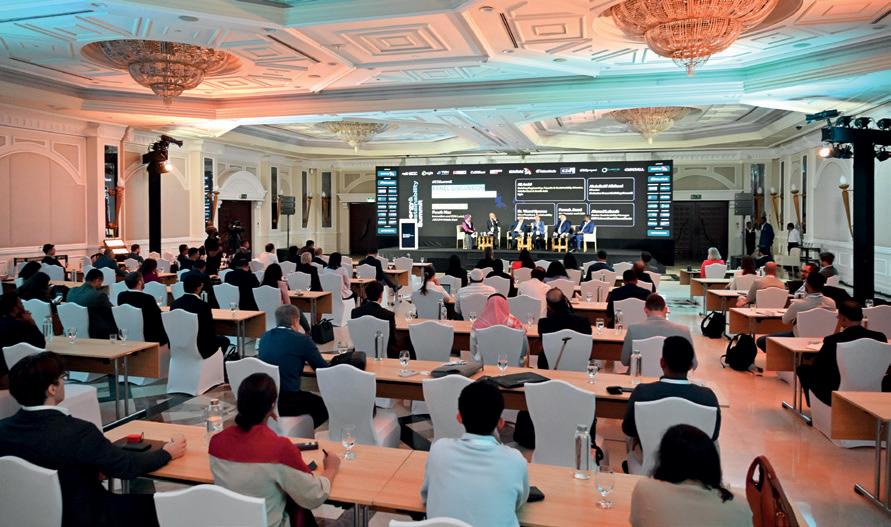






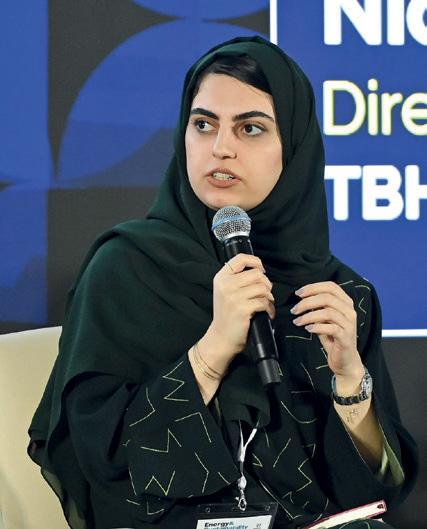








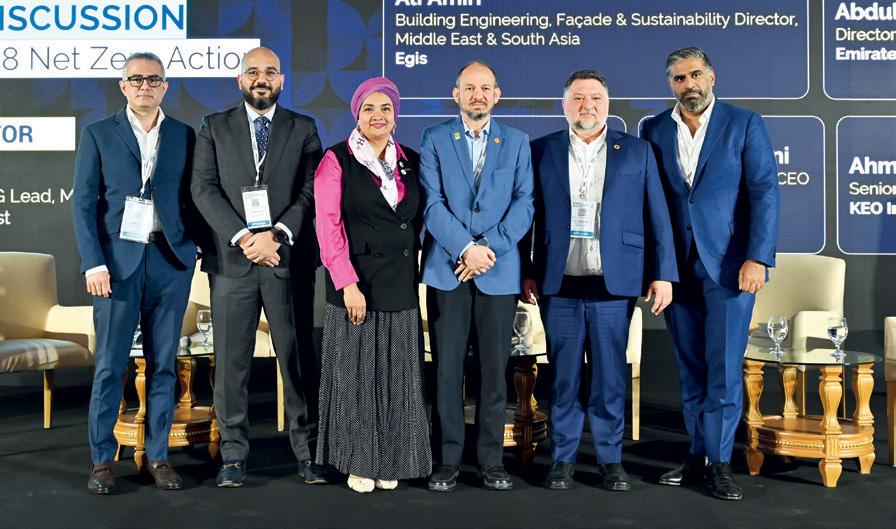


30 April 2024 | MEConstructionNews.com EVENT REVIEW
2024 Energy & Sustainability Summit Event Wrap
The event featured three keynote addresses from senior members of government organisations, three panel discussions, two fireside chats and two presentations
Big Project Middle East’s (BPME)
2024 Energy & Sustainability
Summit took place at the Habtoor Grand Resort, JBR on 7 March and tracked over 150 delegates in attendance. The event saw participation from five government organisations, in addition to dozens of firms from across the built environment and energy sectors.
Delegates and speakers included industry bodies, developers & operators, construction and engineering stakeholders, energy specialists and suppliers, the magazine’s editorial team confirmed. The event was also officially endorsed by the Dubai Supreme Council of Energy.
“I’m immensely proud of the third edition of the Energy & Sustainability Summit, the
event is now unquestionably one of the top decarbonisation and sustainability focused conferences in the region, which is no small feat given the absolutely packed regional event roster. Six other events took place on the same day of the conference, so I’m very grateful to have had five different government organisations participate at the event, all of whom enriched the event’s agenda significantly. They were joined by
experts from a variety of private sector firms, all of whom provided our audience with incredible insights, and food for thought with regards to the ongoing journey towards decarbonisation and achieving Net Zero,” said Jason Saundalkar, Head of Content at Big Project Middle East. He added, “I would like to thank all of our sponsors for throwing their weight behind this keystone event, and look forward


31
MEConstructionNews.com | April 2024 EVENT REVIEW
SUPPORTING PARTNER SUPPORTING PARTNER SUPPORTING PARTNER STRATEGIC SPONSOR BRONZE SPONSOR SUPPORTING PARTNER SUPPORTING PARTNER THANK YOU TO ALL OUR AMAZING PARTNERS AND SPONSORS FOR YOUR SUPPORT PRESENTED BY PRESENTED BY ORGANISED BY ENDORSED BY PRESENTED BY
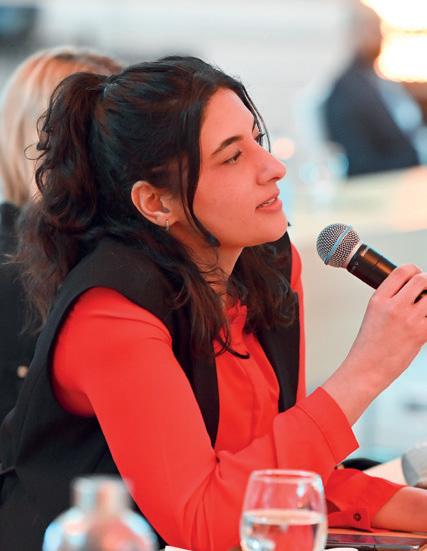

to working with my team to build the next edition in 2025.”
The event opened with a welcome note from BPME’s Head of Content, following which delegates heard from three keynote speakers: Eng. Faisal Ali Rashid, Senior Director – DSM at the Dubai Supreme Council of Energy; Chris Wan, Associate Director of Sustainability and CSR at Masdar City, and Ahmed Jehad Saeed Binsahoo Al Suwaidi, VP - Asset Management at Etihad Water & Electricity (EtihadWE).
Eng. Faisal shared the Dubai Supreme Council of Energy’s roadmap to decarbonise the building sector in Dubai, touching on both new builds and refurbishments. Wan’s
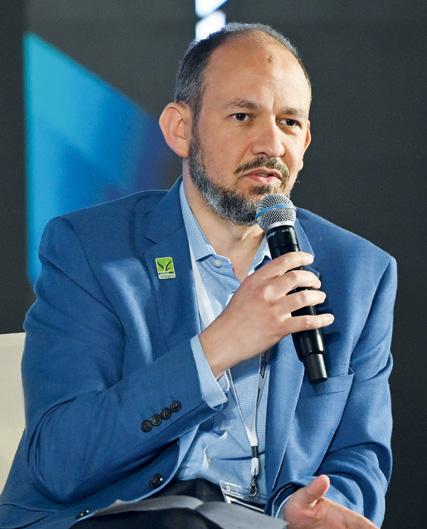
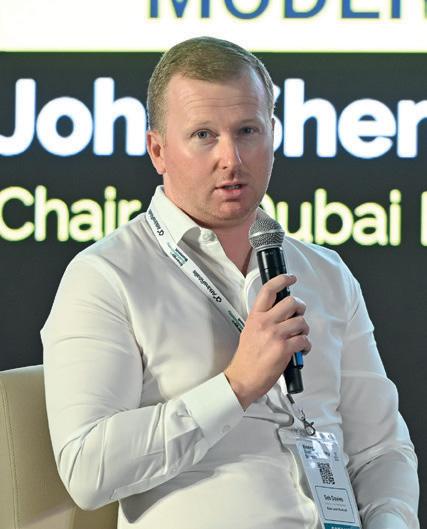

I’m immensely proud of the third edition of the Energy & Sustainability Summit, the event is now unquestionably one of the top sustainability focused conferences in the region”

presentation showcased Masdar City as a case study in sustainable urban development and showcased how cities can achieve Net Zero by balancing passive architectural design, technology and innovation, renewable energy, and holistic master planning.
Al Suwaidi highlighted innovations from Etihad Water & Electricity to deal with increasing energy demands and emphasised the importance of collaboration across all sectors to achieve the UAE’s Net Zero goal in the coming years.
Following the three high level keynote addresses, the first panel discussion ‘Post COP28 Net Zero Action’ took place. The session was moderated by

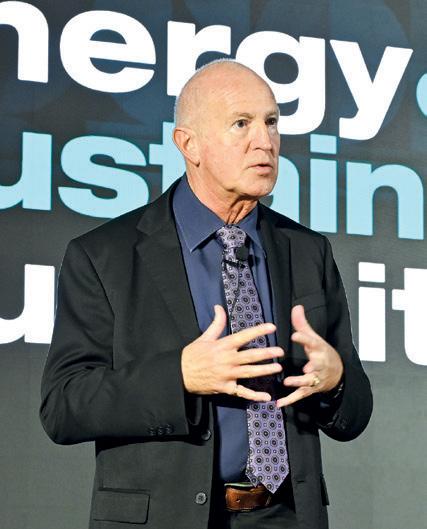

Farah Naz Innovation and ESG Lead, MEA at AECOM Middle East, and featured several speakers including: Ali Amiri, Building Engineering, Façade & Sustainability Director, Middle East & South Asia at Egis; Abdullatif Albitawi, Director at Emirates Green Building Council; Ahmed Labeeb, Senior Sustainability Manager at KEO International Consultants; Dr. Yianni Spanos, Vice President, Sustainability at EXPO City Dubai, and Farouk Jivani, Cofounder and CEO at Zeroe.
The session was followed by a fireside chat with Engi Jaber, CEO and Managing Director at Climatize Engineering Consultants, and was moderated



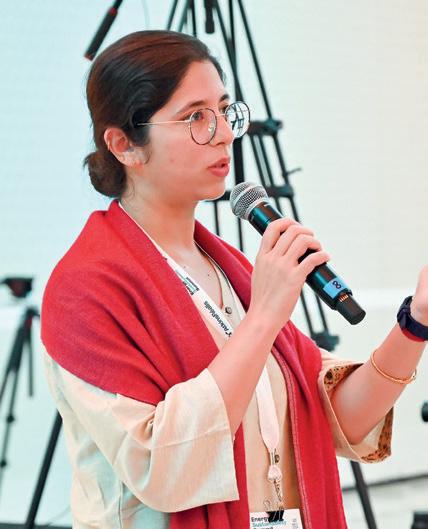
32 April 2024 | MEConstructionNews.com EVENT REVIEW



by Jason Saundalkar. The session focused on a variety of decarbonisation related issues, including key takeaways from COP28 and the growing challenge of green washing in the region.
Maxwell Stanley, Behavioral Scientist at the Department of Energy then gave a presentation which introduced delegates to the world of behavioral science, and how organisations can leverage it to achieve business and societal objectives.
The second panel discussion
‘Sustainable Materials and Decarbonising Construction Sites’ then took place, which was moderated by John Shenton, Chair of Dubai Hub at CIOB. The sessions speakers included:
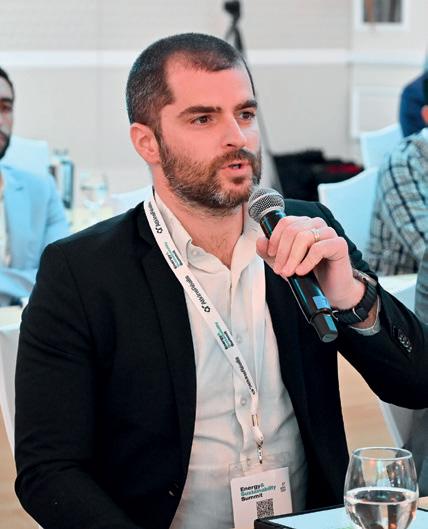


Atousa Aslmainezhad, Assistant Professor of Architecture at Heriot-Watt University Dubai; Basel Khalid Mohammed, Technical & Factory Manager at 3DXB; Calum Perey, Principal Structural Engineer at Cundall; Christopher Nicolas, Director at TBH; Matthias Gelber, NetZero Ambassador for Desert Board and Co-Founder at ESG Innovation Hub Singapore, and Seb Davies, Director – Cost Management at Rider Levett Bucknall.
The second fireside chat of the day was led by Matthias Gelber, who discussed Desert Board – a UAE manufactured palm strand board (PSB) that is made from pruned date palm biomassand its various applications


with Kamal Farah, Director at Desert Board by Al Talah Board Manufacturing Co. Ltd.
The third panel discussion
‘Raising the Middle East’s Clean Energy Game’ was moderated by Boushra Barakat, Senior Environmental Engineer at AECOM, and discussed advancing the region’s clean energy mix. Its speakers included: Abdullatif Albitawi, Vice Chair, Energy Institute Middle East Branch; Dr Tadhg O’Donovan, Deputy Vice Principal at Heriot-Watt University; Riad Bestani, Founder and CEO at ECOSquare; Rola Nasreddine, Energy and Environmental Consultant at Springs Global Consultancy, and Sophia Hasnaoui, Senior



Business Development Manager at Yellow Door Energy.
The final session of the day was led by Atif Rehman, Regional Manager – Middle East at Thinkproject who gave a presentation on the role technology can play in the region’s sustainable development journey. Rehman’s in-depth presentation highlighted the current landscape of clean energy in the MENA region, and discussed how automation and digitalisation are revolutionising efficiency. His presentation also showcased how stakeholders in the region can lead the clean energy transition by leveraging technology for a sustainable future.



33 EVENT REVIEW MEConstructionNews.com | April 2024

NEXT IN Summit
WHAT IS NEXT IN?
The Summit will take place at the ACCIONA Campus in Madrid, Spain from April 24-25
ACCIONA Cultura, the leading cultural firm specialising in the creation of cultural experiences, museums and events, is behind one of the biggest events happening in Spain this coming April: NEXT IN Summit.
NEXT IN Summit 2024, taking place at the ACCIONA Campus (Madrid, Spain) from April 24-25th, aims to serve as a unique gathering to explore what comes next in museums, architecture, design, technology, and sustainability. It’s a platform created by ACCIONA Cultura to connect leaders in the international cultural industry: museum directors, renowned architects and designers, cultural managers and programmers, along with collection and exhibition curators.
This cultural summit will gather over 40 speakers, including artists such as Refik Anadol and Mario Klingemann; architects like Paola Cattarin from Zaha Hadid Architects, Jens Richter from estudio Herreros, Sumayya Vally from Counterspace,
the Director of the Biennale of Islamic Art, and Enrique Sobejano; designers such as Gary Walker Kerr from Haley Sharpe Design, Shirin Brückner from Atelier Brückner, Femke Bijlsma from Kossmann Dejong, Patrick Gallagher from Gallagher & Associates and Nick Appelbaum from RAA. Additionally, we’ll have representatives from Qatar Museums, Louvre Abu Dhabi, Victoria and Albert Museum, Misk Art Institute, Musées d’Orsay et de l’Orangerie and the Grand Palais Immersif, among others.
WHAT WILL WE TALK ABOUT AT NEXT IN?
NEXT IN will provide a space to showcase innovative projects that are transforming public spaces and creating meaningful visitor experiences. The attendees will
40 The summit will gather over 40 speakers, including artists, architects and designers
April 2024 | MEConstructionNews.com 34
SUMMIT ADVERTORIAL ACCIONA

have the chance to go deeply among three different topics during the two days of the event, developed by the more than 40 renowned speakers in different formats: keynotes, presentations and round tables:
1. Latest Trends: crafting meaningful missions for museums
Questions such as how can museums transcend fleeting trends and establish enduring missions that truly resonate with their communities? Or what are the essential qualities that define a meaningful mission for a museum? These will be answered at the summit. According to a global survey conducted by the International Museum Council in 2021, 82% of museums worldwide are actively engaged in redefining their missions and purposes to the changing needs of society.
2. Museums as catalysts for community engagement and positive change
How are museums becoming dynamic hubs of cultural exchanges social progress and sustainable innovation? How can we design for transformation? A study conducted by the American Alliance of Museums revealed that 73% of museums see their leadership role extending beyond cultural preservation to actively addressing contemporary issues such as social justice and environmental sustainability.
3. Transformative power of storytelling: narratives and experiences
How can a museum effectively engage with the different audiences and visitors using a powerful storytelling? And how to balance the use of storytelling with the preservation and interpretation of their collections? The 2022 MCN Annual Survey, which polled over 1,000 professional museums worldwide, found that 85% of respondents reported using immersive technologies such as virtual reality (VR), augmented reality (AR), and mixed reality (MR) in their museums. The agenda can be consulted here: https://nextinsummit.com/agenda/
WHERE?
The two days summit will be held at the headquarters of ACCIONA, the new ACCIONA Campus, located in the heart of Madrid, Spain. A beacon of innovation
and sustainability, ACCIONA’s new campus rises as a testament to the company’s commitment to excellence and environmental consciousness. The campus’s dynamic spaces, brimming with natural light and verdant greenery, provide a stimulating environment for two days of collaborative thinking at NEXT IN. Overall, NEXT IN will be with no doubt a call to action for the museum community to embrace innovation, preserve cultural heritage, and work together to shape the future of culture.
WHO IS BEHIND NEXT IN SUMMIT
ACCIONA Cultura creates museums that become cultural landmarks. Spaces that serve as catalysts for growth, inspiring positive change and enriching the lives of those who visit them. The company crafts unique experiences that transcend
Catalysts for change
A study conducted by the American Alliance of Museums revealed that 73% of museums see their leadership role extending beyond cultural preservation to actively addressing contemporary issues.
the ordinary, pushing the boundaries and exploring new perspectives. Through cutting-edge technology and storytelling, they take people on a journey that ignites curiosity and wonder. ACCIONA Cultura also develops events with a conscious approach, aspiring to leave a mark on people, not on the planet. From choosing the venue to incorporating the latest technology, they aim to ensure that every aspect aligns with our sustainable values.
ACCIONA Cultura is well established in the Middle East. Achievements in the UAE include the National Museum of Oman, Dubai Expo 2020 (Sustainability Pavilion, UAE Pavilion, Spanish Pavilion, Youth Pavilion, Expo Live Pavilion, Thematic Pavilions and Micromuseums), as well as the Shindagha Museums in Dubai and the Qasr Al Watan Presidential Palace in Abu Dhabi.

They also have a strong presence in the Museums, Exhibitions and Events sector in Qatar, with outstanding works such as the design, development and execution of 150 media productions for the National Museum of Qatar; the museum development and implementation of Msheireb Museums, and the production of various temporary exhibitions for Doha’s Museum of Islamic Art and the Orientalist Museum.
ACCIONA Cultura has designed the Net Zero Exhibition as well for Ithra, opened in Dhahran, Kingdom or Saudi Arabia, recently awarded with the iF Design Award 2024. To convey the Net Zero concept, all the elements designed and delivered by ACCIONA Cultura will have a second life when the exhibition finishes (October 2024), adhering to a zero-waste philosophy. https://cultura.acciona.com
ACCIONA Cultura is part of the ACCIONA Group, a global company leading the transition towards a lowcarbon economy by addressing some of the planet’s most pressing challenges through sustainable infrastructure solutions. With several projects here in the Middle East region carried out by their different sustainable solutions (specially Water and Transport solutions), through ACCIONA Cultura, ACCIONA aims to contribute to the foundations of a prosperous society and ensure public welfare.
35 MEConstructionNews.com | April 2024
ADVERTORIAL
Pump Efficiency
Promoting Sustainable Operations
Wilo Middle East’s Yasser Nagi shares his thoughts on modern tools that are designed to improve pump efficiency and promote sustainable operations
The importance of precision pump selection is extremely high in the field of industrial operations, where sustainability and efficiency are critical requirements. Pump dimensioning is undergoing a radical change as a result of the development of sophisticated online tools, opening the door to a new era of sustainability and efficiency.
According to industry reports, the industrial pumps market will grow from US $64.82bn in 2023 to $87.15bn in 2028 at a compound annual growth rate (CAGR) of 6.1%. In the past, however, pump selection processes were timeconsuming and tedious. Engineers and operators now have access to a suite of cutting-edge tools that automate the
entire dimensioning process, from initial assessment to final implementation. By precisely matching pump specifications with application requirements, these tools leverage cutting-edge technology to optimise energy usage and drastically lower operating costs. One of the most effective tools integrated into modern pump dimensioning systems is the concept of Life Cycle Cost (LCC) analysis. LCC analysis offers a complete evaluation of a pump’s efficiency over the course of its whole lifespan by factoring in maintenance, energy consumption, and eventual replacement, in addition to the upfront costs of installation. By ensuring optimal efficiency and cost-effectiveness throughout the operational lifecycle, stakeholders can also make informed

April 2024 | MEConstructionNews.com 36
COMMENT
MIDDLE EAST

decisions regarding pump replacements.
Today, a growing number of businesses in the pump sector are using artificial intelligence (AI) tools to increase productivity. For instance, the ‘Fault Signal Assistant’ provides critical information about possible signals of failure for certain pump products. The tool not only pinpoints the source of the issue, but also gives a complete description of the problem and step-bystep instructions for getting it resolved.
The Pipe Calculator, which determines the differential pressures between planned and existing pipes based on flow rate input, is another useful tool. This tool helps with system design and optimisation by accurately estimating the resulting pressure differentials by taking into account variables like pipe length and resistance.
There are numerous other technologies available to further improve pump efficiency. One notable example is Variable Frequency Drives (VFDs). VFDs ensure maximum efficiency by precisely matching the pump’s output to the system demand by varying the motor’s rotational speed. In addition, advanced controllers and ultrasonic systems have been identified as crucial for reducing energy costs and prolonging pump life.
Modern software solutions, like specialised pump selection software,
also function as configuration and consultancy tools, allowing users to quickly select the appropriate pump type for a given application. They also provide a replacement guide that indicates which pumps would be best if they ever need to be replaced. Today’s market also provides software solutions that enable comprehensive communications through smart technologies, such as smart connections to pumps and pump systems that provide businesses with an overview of installation locations and
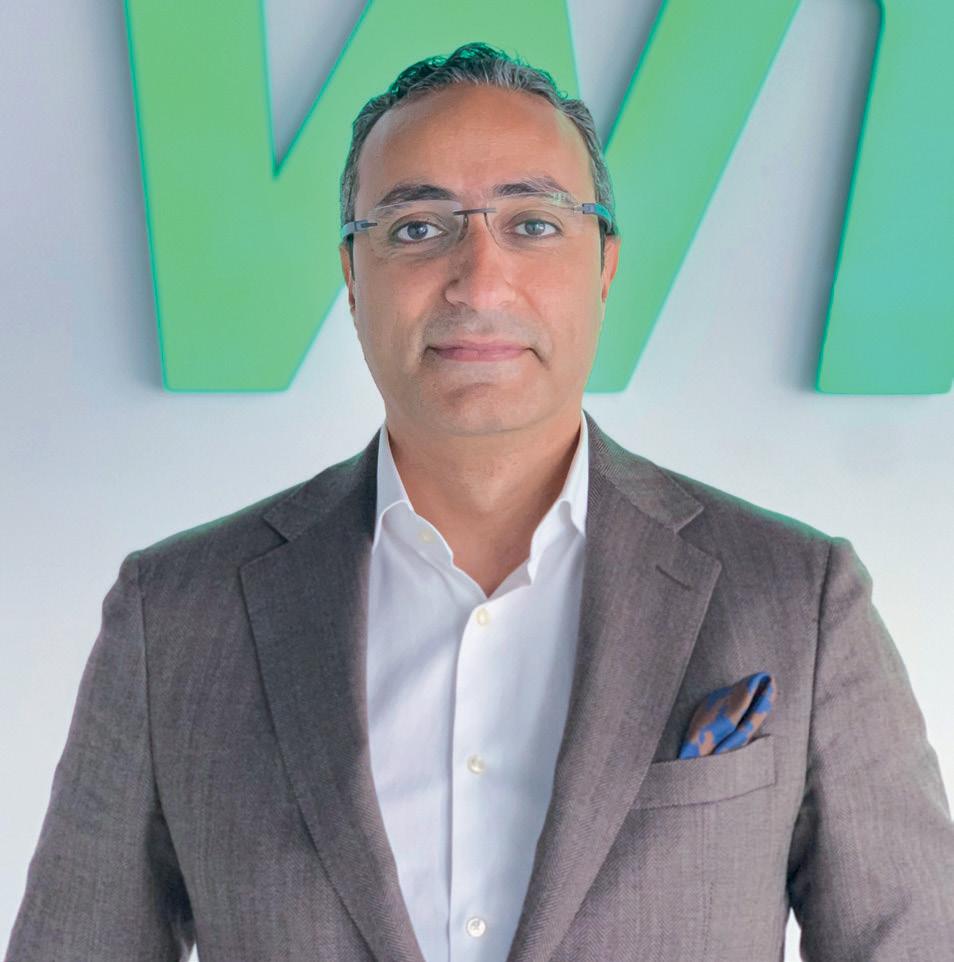
operating conditions while on the go. Beyond the scope of operational efficiency, all of these features have the potential to significantly impact sustainability by offering realtime monitoring and analytics. By increasing pump efficiency, industries can significantly reduce their energy consumption and carbon footprint. From lower greenhouse gas emissions to the preservation of limited natural resources, every kilowatt-hour saved has a positive impact on the environment. One of the most significant advantages of these advanced tools is their ease of use. These platforms are designed with convenience in mind, allowing users to navigate through a multitude of pump options with unparalleled speed and ease. Intuitive interfaces and comprehensive databases allow for quick comparisons between different models, enabling engineers to make sound choices in a timely manner. The emergence of advanced online tools for pump dimensioning marks an important development in the quest for efficiency and sustainability. As we continue to embrace this next generation of tools for sustainability and efficiency, we are paving the way for a better, cleaner future for generations to come.
37 MEConstructionNews.com | April 2024
COMMENT
Effective solution By increasing pump efficiency, industries
significantly reduce their energy consumption and
At the helm Yasser Nagi, Managing Director, of Wilo Middle East.
can
carbon footprint says Nagi.
Paint
Protecting Infrastructure

MIDDLE EAST
Jotun UAE’s Calvin Reck on paint’s role in prolonging infrastructure lifespan and combating corrosion
In the expansive realm of infrastructure development, where towering skyscrapers, intricate bridges and a plethora of other developments shape our urban landscapes, there exists an uncelebrated element – paints. These seemingly mundane coatings might appear to only add to the aesthetics of structures, however with their protective prowess, they play an instrumental role in extending the life of structures,
and act as an impervious shield against the relentless forces of corrosion.
Material damage brought on by electrochemical reactions with the environment is known as corrosion. Metallic corrosion in specific has been a concern in the use of metals since long ago. Since a great percentage of structures worldwide are made from some sort of metal, construction companies and developers need to take this into account, since metallic corrosion causes infrastructure to slowly deteriorate and crumble over time if not looked after.
Exposure to harsh climates, gaseous impurities in the air, water and other elements usually cause corrosion. In this regard, bridges, steel-reinforced concrete, pipelines and skyscrapers are widely affected, and unfortunately, in such structures, corrosion is not always easily detected or visible to the naked eye. Therefore, corrosion is an omnipresent threat to metal structures, and not only poses a significant economic burden but also raises environmental concerns.
HOW PAINT CAN HELP COMBAT CORROSION
According to a study published in the Journal of Materials Science, corrosionrelated expenses can account for up to 4% of a country’s GDP, emphasising the urgency for effective preventive measures. The insidious nature of corrosion necessitates a strategic approach, and paints emerge as the frontline defenders. Beyond their aesthetic appeal, paints transform into shields, providing a barrier against deterioration that results from constant exposure to environmental elements. Some paints even consist of active ingredients designed to collect at areas where corrosion has begun and inhibit further corrosion.
The National Association of Corrosion Engineers (NACE) based in Canada emphasises the significance of barrier coatings in impeding the penetration of moisture and corrosive agents, thereby safeguarding the structural integrity of metals. This underscores the critical role of paints as a proactive
4% Corrosionrelated expenses can account for up to 4% of a country’s GDP
April 2024 | MEConstructionNews.com 38
COMMENT
Protective coating
The American Society for Testing and Materials has highlighted the role of protective coatings in mitigating the impact of corrosive environments on infrastructure.
defense mechanism against the adverse effects of weather, industrial pollutants, and various corrosive agents that threaten the longevity of structures.
Therefore, it is crucial to appreciate the broader understanding of paints’ role in infrastructure longevity. Recognising the right choice of paint, with proper corrosion-resistant properties, is paramount in ensuring the sustainability and durability of infrastructure projects across the globe. In this regard, big industry players in protective coatings have developed research-backed and tried and tested paints and coatings to counter corrosive elements and extend the lifespan of infrastructure.
The economic implications of corrosion are staggering. The World Corrosion Organisation estimates a global cost of US $2.5tn annually (including contribution from infrastructure corrosion), posing a substantial burden on economies worldwide. Investing in high-quality paints that offer robust corrosion protection thereby becomes an economically sensible strategy, significantly mitigating the financial burdens associated with maintenance and repair.
Moreover, a study conducted by the American Society for Testing and Materials (ASTM) underscores the pivotal role of protective coatings in mitigating the impact of corrosive environments on infrastructure. This further solidifies the argument that paints are not merely cosmetic elements but integral components in the ongoing battle against corrosion. Preventive capabilities of paints such as crack-bridging and special powder coatings also contribute to the long-term sustainability of structures, aligning with the principles of responsible infrastructure development.
Infrastructure projects, ranging from bridges to oil rigs and much more often operate in extreme environmental conditions. The Journal of Coatings Technology and Research stresses the importance of tailored coatings formulated to withstand specific environmental stressors. This tailored approach ensures that the protective coating effectively meets the challenges posed by diverse sectors, underlining the need for precision in paint selection from reputed companies like Jotun and others.
CORROSION PROTECTION FROM FIRE
Fire safety is an integral element of safeguarding infrastructure, therefore it is usually considered together with corrosion-prevention for paints. The use of fireproofing paints, or intumescent paints, adds another layer of resilience to steel structures. When exposed to high temperatures, intumescent coatings expand, forming a stable char that acts as an insulating barrier. This prevents further spreading of the fire and delays the time it takes to reach structural failure temperatures, ranging from 520 to 750 degrees Celsius. Beyond contributing to the safety of structures, this fireproofing measure significantly reduces the need for total steel replacement after a fire, thereby reducing maintenance costs and reducing resource consumption. With steel being a preferred building material for various structures due to its design flexibility, cost-effectiveness, and durability, addressing both corrosion and fire safety becomes paramount. As the popularity of steel in construction continues, the importance of selecting the right paints for corrosion prevention and fireproofing requirements cannot be overstated. This strategic approach ensures not only the resilience of individual
$2.5tn
The estimated annual global cost of corrosion is US $2.5tn, according to The World Corrosion Organisation

structures but also the overall safety and longevity of megastructures such as skyscrapers, airports, and stadiums.
ENVIRONMENTAL IMPACT
In addition to the critical role that paints play in corrosion prevention and fire safety, their impact extends to energy efficiency and environmental sustainability. Innovative reflective coatings, designed to minimise heat absorption and reduce surface temperatures, contribute to lower energy consumption in buildings. Studies, such as those published in the ‘Journal of Coatings Technology and Research’, delve into the thermal properties of these coatings, demonstrating their potential to enhance the energy performance of structures in various climatic conditions.
By mitigating the urban heat island effect and decreasing the reliance on air conditioning systems, these reflective paints not only promote energy efficiency but also align with global efforts to address climate change. Integrating such environmentally conscious practices into the discourse surrounding paints further emphasises their multifaceted contributions to the overall health and resilience of our built environment.
Moreover, the issue of corrosion extends beyond economic repercussions. It poses a substantial environmental concern, as corroded structures often lead to material wastage and increased carbon emissions associated with replacement and repair activities. Addressing corrosion through advanced coatings not only ensures the longevity of structures but also aligns with sustainable development goals by reducing the environmental footprint of infrastructure projects. Paints are silent guardians that play a multifaceted and indispensable role in extending the lifespan of our infrastructure, combating corrosion, and enhancing fire safety. The choice of the right paint is a strategic decision that goes beyond visual appeal, contributing to the resilience, durability, and safety of structures. As construction companies and developers navigate the complexities of infrastructure development, it is crucial to appreciate the profound impact that the correct choice of paints can have on the built environment.
39 MEConstructionNews.com | April 2024
COMMENT Coating specialist Calvin Reck, Protective Coatings Sales Manager – Jotun UAE.
RTA completes construction of internal roads
The completion is said to reflect the RTA’s commitment to upgrading roads, streetlights, and rainwater drainage systems in residential areas
Dubai’s Roads and Transport Authority (RTA) has completed construction works on the internal roads at Margham, Lehbab, Al Lesaili, and Hatta regions, spanning a total of 35km.
This comes close on the heels of RTA’s recent completion of the

construction of internal roads at three residential districts – Al Quoz 2, Nad Al Sheba 2 and Al Barsha South 3 – extending 37km across the three districts.
In addition, the RTA has started further road works at both Lehbab and Al Lesaili, designed to improve traffic flow and enhance local residents’ access.
The Margham project covers roads extending 5km along Dubai-Al Ain Road, near Skydive Dubai. The work includes road pavements, drainage networks and streetlights. The project will serve more than 1,100 local residents.
Meanwhile, the Lehbab project includes paving roads extending 4km, as well as drainage and streetlights. The project will directly serve more than 3,000 residents.
The Al Lesaili project will cover street lighting works for
35
The latest works on internal roads span a total of 35km
the existing roads at Saih Assalam near the Last Exit, and Al Qudra Lakes, extening over 7km. The project, which serves about 2,900 residents, will focus on improving the entry/exit points of the area, the RTA explained in its statement.
Announcing project completion, Mattar Al Tayer, Director-General, Chairman of the Board of Executive Directors, RTA said, “The project reflects RTA’s commitment to upgrading the infrastructure of roads, streetlights, and rainwater drainage systems in residential communities. The project covers the construction of roads extending 2km at Suhaila in Hatta in addition to infrastructure works that include rainwater drainage and streetlights. It serves about 6,000 residents and improves the entry/ exit points as well as the connection of the newly developed residential community with the road network.”
40 PROGRESS REPORT
Update
Final
April 2024 | MEConstructionNews.com Residential focus The infrastructure projects are aimed at easing traffic flow, better connecting residential areas and enhancing rainwater drainage.


Optimized drain intervals
Now you can increase significant savings through a dedicated tool developed and managed by TotalEnergies.
Presenting, LubAnac is a Fleet Management System, to reduce your vehicle maintenance costs through oil analysis that:
Reduces downtime of your fleet
Optimizes the maintenance
Increases the lifetime of your vehicles
Reduces total cost of ownership (TCO)
totalenergies.ae

It’s more than BIM, It’s accelerating collaboration and productivity in engineering
design teams
To design next-generation capital assets within budget and timelines, engineering designers must have access to cutting-edge software that accelerates collaboration and productivity.
Adopting an integrated design and configuration approach, gives you more than the benefits of a BIM solution, it also:
• Helps your design teams bring innovative new solutions to market and operations faster
• Gives your engineers access to advanced cloud-based technologies including simulation-driven design, artificial intelligence, machine learning and additive manufacturing
• Enables unprecedented speed, efficiency and collaboration within your design teams
Scan the QR code to read the executive brief














 Jason Saundalkar HEAD OF CONTENT
Jason Saundalkar HEAD OF CONTENT











































































































